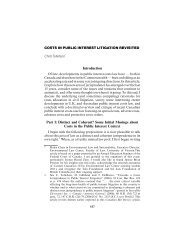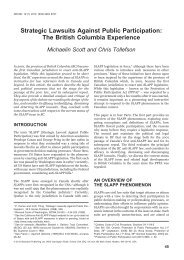Peeling back the Pavement - POLIS Water Sustainability Project
Peeling back the Pavement - POLIS Water Sustainability Project
Peeling back the Pavement - POLIS Water Sustainability Project
Create successful ePaper yourself
Turn your PDF publications into a flip-book with our unique Google optimized e-Paper software.
BOX 6: THE BUSINESS CASE FOR THE RAINWATER CITY<br />
Many studies have shown that storing and treating stormwater runoff costs more than reducing<br />
<strong>the</strong> amount of stormwater generated at <strong>the</strong> source. Studies in Maryland and Illinois<br />
have shown that new residential developments that use green infrastructure stormwater<br />
controls can save US$3,500 to $4,500 per lot compared with conventional new development.<br />
A recent study from <strong>the</strong> University of Guelph found that when all costs, including<br />
environmental costs, are taken into account, <strong>the</strong> cost of implementing rainwater capture<br />
systems is comparable to <strong>the</strong> cost of implementing conventional stormwater systems.<br />
In 2009, <strong>the</strong> City of Philadelphia commissioned a study to compare traditional stormwater<br />
management techniques with a green infrastructure approach. The study used<br />
a triple-bottom-line analysis to capture <strong>the</strong> benefits of a variety of factors including<br />
increased recreational opportunities, improved aes<strong>the</strong>tics and property value, and water<br />
quality and aquatic habitat enhancement. US$122 million in benefits were expected<br />
from <strong>the</strong> traditional approach while <strong>the</strong> green infrastructure option was expected to<br />
yield benefits of $2,846 million—a difference of 23 to one. As a result, Philadelphia is<br />
pursuing one of <strong>the</strong> most ambitious rainwater programs in North America through its<br />
Green City, Clean <strong>Water</strong>s plan.<br />
Although it is simpler to design a<br />
green development from scratch than<br />
to incorporate green infrastructure<br />
into existing developments and buildings,<br />
retrofitting is both important<br />
and doable, particularly when it can<br />
piggy<strong>back</strong> on replacements and repairs<br />
that need to be made. An analysis conducted<br />
by <strong>the</strong> City of Vancouver showed<br />
that incorporating green infrastructure<br />
into locations with existing conventional<br />
stormwater controls would cost only<br />
marginally more than rehabilitating <strong>the</strong><br />
conventional system, and introducing<br />
green infrastructure into new developments<br />
would cost less. Seattle Public<br />
Utilities estimated that using green<br />
infrastructure techniques in place of<br />
Photo: S. Porter-Bopp<br />
Dockside Green, a mixed-use development built to house<br />
2,500 people in Victoria, B.C., demonstrates integrated<br />
stormwater management strategies. Naturalized artificial<br />
creeks and retention ponds clean and control stormwater<br />
flows. Green roofs retain and recycle water by directing<br />
overflow into rain cisterns on each resident's balcony,<br />
providing water for planters and houseplants. Excess water<br />
is directed to <strong>the</strong> naturalized creeks and ponds on site.<br />
conventional sidewalks, curbs, gutters, and catch basins could reduce construction costs<br />
by 24 per cent to 45 per cent in street redesign projects. In <strong>the</strong> City of Portland, <strong>the</strong><br />
Bureau of Environmental Services will save more than $58 million through <strong>the</strong> largescale<br />
integration of green infrastructure and targeted pipe replacement and repairs in its<br />
Brooklyn Creek Basin project. The total cost of <strong>the</strong> project will be 40 per cent less than<br />
<strong>the</strong> cost of traditional infrastructure solutions.<br />
Sources on page 65.<br />
57












